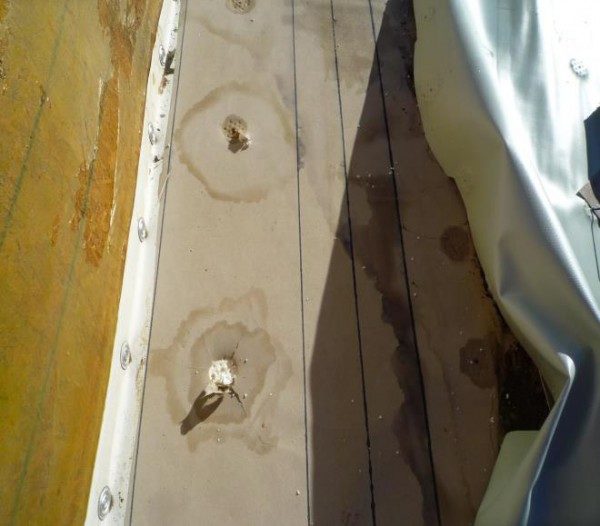Guest Blog: White Single-Ply Roofing Membrane For Your Next Project? Not So Fast!
Today, the majority of new roofing is a white single-ply membrane, either TPO (thermoplastic polyolefin) or PVC (polyvinyl chloride). This is due mostly to new energy codes that require reflective roofing to reduce heat absorption into the structure. Over the past several years we have investigated moisture build-up and damage to building materials occurring underneath this type of roofing on numerous occasions. The purpose of this article is to get the word out that night-time radiant cooling environments are causing detrimental moisture conditions affecting white single-ply roofing systems.
These wet roof systems are a common problem and the design and installation methods that got us into this situation must be changed to avoid making the same mistakes over and over again. Another overlooked concern relates to how the membranes are attached to the substrates. Fasteners are time-consuming to install and sources of thermal bridging with associated moisture while the use of water-based adhesives are rendered ineffective if exposed to cold-freezing temperatures and constantly wet conditions.
For the large number of owners who have had these roofing membranes installed, yes, you may have moisture build-up under your roofing and membrane adhesives that are ineffective or compromised by long-term moisture and you may not even realize it is happening. Because of this, you should have your roof assembly and the roof framing structure beneath the membrane investigated to determine if your roof system is wet, and if so, to what extent has the moisture damaged the components adjacent to and under the roof membrane?
How did we get here? First a quick description of climatic conditions on a typical roof in San Diego, CA. San Diego is of particular concern as the climate is mild, and as a result many building owners, their designers, and roofing contractors do not incorporate required climate-based methods into the designs and during field installations.
Let us look at a typical commercial building with a low-slope (less than 2:12) white single-ply membrane roof. We have selected ball-park numbers to illustrate sample conditions and resulting concerns. Let’s establish that the average indoor temperature is 70 degrees F (Fahrenheit) and corresponding indoor humidity level is 50%. At these conditions moisture will condense on a surface that is 50 degrees F. Next factor to consider is radiant cooling to a clear night sky. Horizontal surfaces exposed to a clear night sky loose heat faster than other surfaces. Estimates are that a white surface will be 10-20 degrees colder, (we will use 15 for this example), than the ambient (surrounding) air temperature. Winds blowing over the surface are another factor, but will be ignored for this case.
A white membrane roof in San Diego will reach a dew point (the point when the temperature below which the water vapor in air at constant barometric pressure condenses into liquid water at the same rate at which it evaporates). The condensed water is called dew when it forms on a solid surface. This can occur when the night air temperature is at or below approximately 65 degrees! (65 degrees air temperature less 15 degrees radiant cooling results in an effective surface temperature of 50 degrees). Most nights in San Diego year round, have the potential climatic conditions for condensation under single-ply roof membranes. If the membrane is adhered or fastened, the constantly wet adhesive is susceptible to deterioration and failure or the hundreds (or thousands) fasteners are thermal conduits spewing moisture into the roof assembly, rusting, and causing drippage to the interior space.
Regarding the application of the adhesive during roofing, most products prohibit installations if the temperature is below 40 deg. F and other say 45 deg F. This refers to air temperature not surface and this is very important. Let’s look at a sample scenario at 7am in San Diego; clear skies, and a temperature of 50 deg F. The roof surface is much colder from night time radiant cooling effect so the surface temperature is very close to freezing and well below the recommend temperature for the adhesive to be effective. The next night let’s say the air temperature goes down to 50. Radiant cooling brings the roof surface down to the low 30’s. The adhesive is requiring a 48-hour curing period. The effects of night cooling prohibit the adhesive from reaching the recommended minimum temperature for the curing period and condensation under the membrane further interferes with proper curing.
In these same conditions, most buildings have warm, moist interior air seeping up into the roofing system that eventually contacts the underside of the colder roofing membrane. This allows condensation to occur and introduce moisture into the building under the membrane. One procedure often recommended is to install a vapor barrier on the warm interior side to block the warm moist air flow. This is a seriously flawed practice and can actually make conditions worse. Over time, this moisture build-up leads to disintegration of any cover board, the adhesives used to hold down the roofing, and any insulation. Also any metal in the system is now rusting, wood is dry rotting, and don’t forget bio-organic growth (mold) which thrives in these environments.
In summary, if you consider using a white single-ply roofing membrane for your re-roof or new roof, make sure to consult with a knowledgeable firm that understands the micro-climate risk and can design a complete system that manages the potential moisture build-up and adhesion problems. If you currently have a white single-ply roof, have it inspected by one of these professionals to determine if moisture condensation build-up is affecting your building and for recommendations to mitigate the problem.
This guest blog was originally published by LOhSE2 LLC

